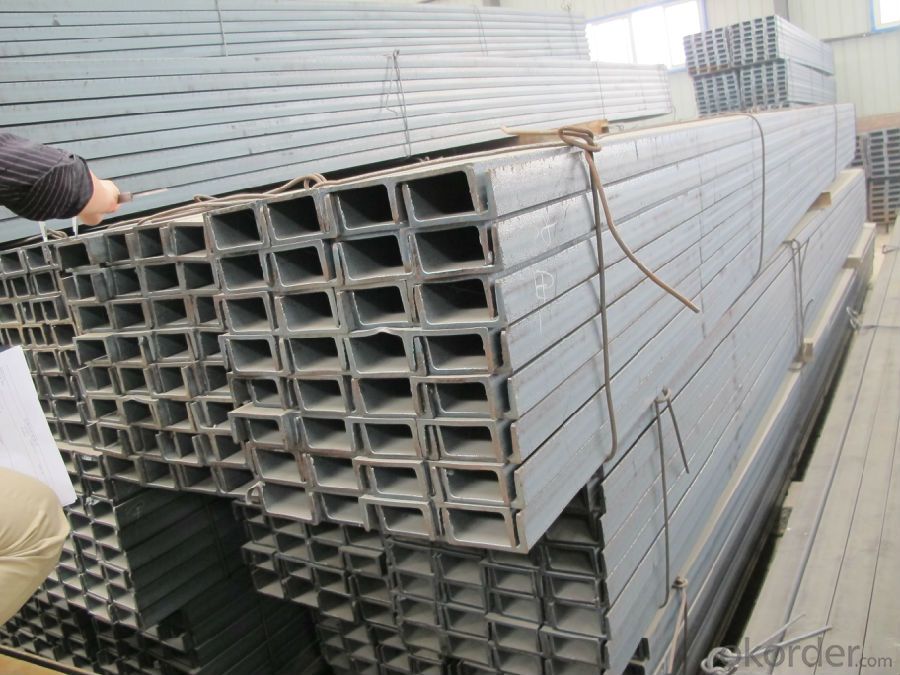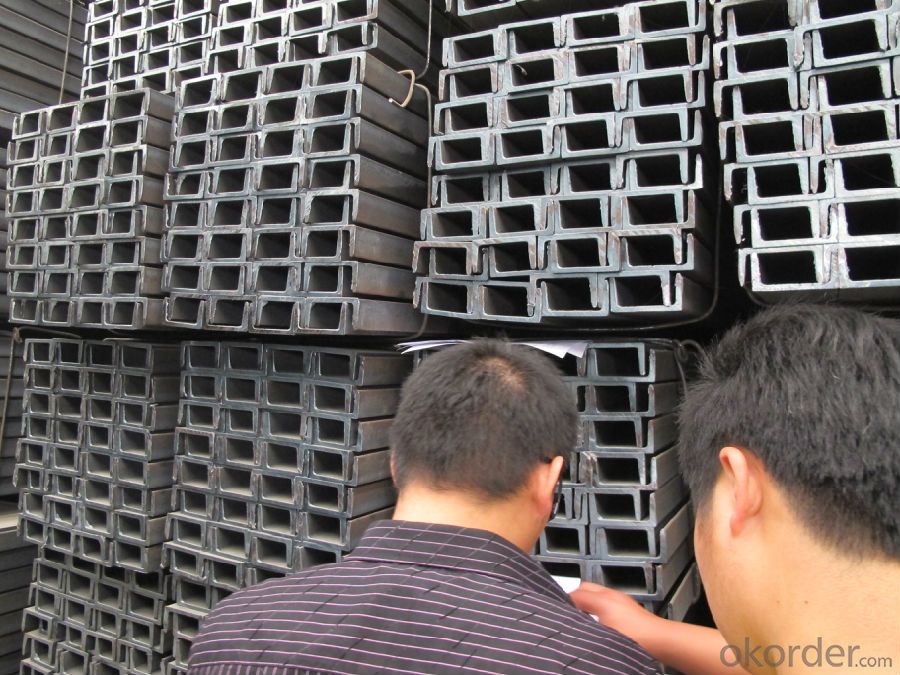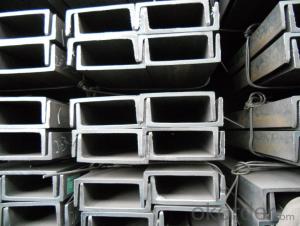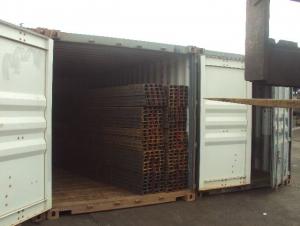U-channel Carbon Steel JIS Standard Many Sizes Hot Rolled
- Loading Port:
- Tianjin
- Payment Terms:
- TT OR LC
- Min Order Qty:
- 25 m.t.
- Supply Capability:
- 2000 m.t./month
OKorder Service Pledge
OKorder Financial Service
You Might Also Like
Product Description:
OKorder is offering U-channel at great prices with worldwide shipping. Our supplier is a world-class manufacturer of steel, with our products utilized the world over. OKorder annually supplies products to European, North American and Asian markets. We provide quotations within 24 hours of receiving an inquiry and guarantee competitive prices.
Product Applications:
1.The JIS channel can be devided into two kinds, namely common channel steel and light channel steel. The sizes of hot rolled common channel steel range from 5# to 40#. Meanwhile, the channel steel can be divided into cold forming sectional equal channel steel, cold forming sectional unequal channel steel, cold forming inner edge channel steel and outer edge channel steel.
2.The JIS channel is usually used for arch-itechtural structure, and they could be welded in order to support or hang a vari-ety of facilities. They are also usually used in combination with I beam. The channel steel with sizes under 14# is usually applied to construction engineering, as purline, while the channel steel with sizes above 16# is more likely to be used in building vehicle chassis structure and mechanical structure. Furthermore, the channel steel in sizes above 30# are target at building bridge structure, as tension bar.
Product Advantages:
OKorder's U-channel are durable, strong, and resist corrosion.
Main Product Features:
· Premium quality
· Prompt delivery & seaworthy packing (30 days after receiving deposit)
· Corrosion resistance
· Can be recycled and reused
· Mill test certification
· Professional Service
· Competitive pricing
Product Specifications:
1.We are able to provide channel steel of top quality at attractive price.
2.Our products of channel steel have passed ISO9001:2008 Quality Management System Certification.
Alloy No | Grade | Element (%) | |||||
C | Mn | S | P | Si | |||
Q235 | B | 0.12—0.20 | 0.3—0.7 | ≤0.045 | ≤0.045 | ≤0.3 | |
Alloy No | Grade | Yielding strength point( Mpa) | |||||
Thickness (mm) | |||||||
≤16 | >16--40 | >40--60 | >60--100 | ||||
≥ | |||||||
Q235 | B | 235 | 225 | 215 | 205 | ||
Alloy No | Grade | Tensile strength (Mpa) | Elongation after fracture (%) | ||||
Thickness (mm) | |||||||
≤16 | >16--40 | >40--60 | >60--100 | ||||
≥ | |||||||
Q235 | B | 375--500 | 26 | 25 | 24 | 23 | |
Note of U-channel
1. According to national standard (GB) for our products, if not, supply according to national standards (GB) or agreement.
2. We can not only provide electric furnace +LF+VD and electros lag re-melting (ESR) steel forging materials, but also forging products of piece, bar, etc.
3. Our company is equipped with roll equipment and can provide our customers with roll billets or finished.
4. The materials that we purchase are all accord with International General Standard; you could check it out on the Material Quality Sheet.
5. We are the creator of the “seven-step inspect method” in China.
6. The technical workers we employed are the ones with many years’ working experience, who know the technology procedures very well.
FAQ:
Q1: Why buy Materials & Equipment from OKorder.com?
A1: All products offered byOKorder.com are carefully selected from China's most reliable manufacturing enterprises. Through its ISO certifications, OKorder.com adheres to the highest standards and a commitment to supply chain safety and customer satisfaction.
Q2: How do we guarantee the quality of our products?
A2: We have established an advanced quality management system which conducts strict quality tests at every step, from raw materials to the final product. At the same time, we provide extensive follow-up service assurances as required.
Q3: How soon can we receive the product after purchase?
A3: Within three days of placing an order, we will begin production. The specific shipping date is dependent upon international and government factors, but is typically 7 to 10 workdays.
Images:


- Q:What are the different methods of anti-slip treatment for steel channels?
- Some common methods of anti-slip treatment for steel channels include applying non-slip coatings or paints, using abrasive strips or tapes, welding on anti-slip gratings or plates, or using adhesive-backed anti-slip products.
- Q:What are the considerations for steel channel bracing?
- Some considerations for steel channel bracing include the load requirements, structural stability, connection details, material specifications, and the overall design intent. The bracing should be designed to resist the applied loads and provide adequate support to prevent buckling or excessive deflection. The connection details must be carefully planned to ensure proper transfer of forces between the bracing and the main structure. Additionally, the material specifications should be chosen based on the specific project requirements, considering factors such as durability, corrosion resistance, and fire resistance. Overall, the design of steel channel bracing should be carefully evaluated to ensure it meets the desired safety and performance criteria.
- Q:How do steel channels contribute to sustainable design in buildings?
- Steel channels contribute to sustainable design in buildings in several ways. Firstly, steel is a highly durable and long-lasting material, which means that buildings constructed with steel channels have a longer lifespan, reducing the need for frequent renovations or replacements. This results in less waste generation and a lower environmental impact. Secondly, steel is a recyclable material, which means that steel channels can be recycled and reused after the end of their life cycle. This helps to reduce the demand for new steel production and the associated energy consumption and greenhouse gas emissions. Additionally, steel channels allow for efficient and flexible design options, enabling the construction of lighter and more efficient structures. This leads to reduced material consumption, improved energy efficiency, and lower carbon footprint during the construction and operation phases of the building. Furthermore, steel channels are often used in prefabricated construction methods, which can significantly reduce construction waste, minimize on-site disruption, and improve overall construction efficiency. Overall, the use of steel channels in building design contributes to sustainability by promoting durability, recyclability, energy efficiency, and reduced waste generation, making it a preferred choice for sustainable building practices.
- Q:Can steel channels be used for supporting rooftop solar arrays?
- Yes, steel channels can be used for supporting rooftop solar arrays. Steel channels provide strength, durability, and stability, making them suitable for bearing the weight of solar panels and withstanding various environmental conditions. Additionally, steel channels can be easily installed and adjusted to accommodate the specific requirements and layout of a rooftop solar array.
- Q:How do steel channels contribute to load distribution?
- Load distribution is a crucial function performed by steel channels, which are structural components. These channels are specifically designed to bear heavy loads and transfer them to other supporting elements like beams, columns, or walls. The shape and design of steel channels enable them to efficiently distribute weight and forces applied to them. Steel channels contribute to load distribution primarily by offering a stable and rigid pathway for transferring loads. When a load is applied to a steel channel, it evenly distributes the weight along its length, avoiding the creation of concentrated stress points. This even distribution is crucial in minimizing the risk of structural failure or deformation under heavy loads. Additionally, steel channels often act as secondary support members, helping to distribute loads to primary load-bearing elements. They can be attached to beams, columns, or walls to provide extra support and reinforcement. By connecting different structural elements together, steel channels effectively distribute loads across the entire system, preventing localized stress concentrations and ensuring overall stability and strength. Furthermore, steel channels can be combined with other structural components like steel plates or angles to create composite sections that enhance load distribution capabilities. Engineers can optimize load distribution by utilizing the specific properties of each component and combining different shapes and sizes. In conclusion, steel channels play a critical role in load distribution. They evenly distribute loads, provide additional support to primary load-bearing elements, and create composite sections for enhanced load distribution. Their design and versatility make them essential in ensuring the structural integrity and safety of various types of buildings and structures.
- Q:What are the different shapes of steel channels?
- Steel channels come in a variety of shapes, including C-channel, U-channel, and J-channel. C-channels have a C-shaped profile and are commonly used for structural support in construction. U-channels have a U-shaped profile and are often utilized as framing or edging material. J-channels have a J-shaped profile and are typically employed for trim or finishing purposes, such as around windows or doors.
- Q:What do you mean by channel 8 A?
- 8# refers to the diameter of the channel, (MM) A, I have not heard of, perhaps I am not professional, channel steel used by me
- Q:What does channel steel look like? Where is it usually used?
- Channel steel is a strip of steel with a cross section. The specifications of the method, such as 120*53*5, mean waist height of 120 mm, leg width of 53 mm channel, waist thickness of 5 mm channel, or called 12# channel. Channel steel is mainly used in building structures, vehicle manufacturing and other industrial structures, and channel steel is often used in conjunction with i-beam.
- Q:Can steel channels be used for supporting exterior shading devices?
- Yes, steel channels can be used for supporting exterior shading devices. Steel channels are commonly used in construction for their strength and durability, and they can provide a sturdy framework for supporting shading devices such as awnings, canopies, or louvers. The channels can be securely attached to the building's exterior and provide a stable base for the shading device. Additionally, steel channels can be customized and fabricated to meet specific design requirements, allowing for flexibility in the installation of exterior shading devices.
- Q:What are the different fabrication techniques for steel channels?
- There are several different fabrication techniques for steel channels, including hot rolling, cold rolling, and extrusion. Hot rolling involves heating the steel to high temperatures and then passing it through a series of rollers to shape it into the desired channel profile. Cold rolling, on the other hand, is performed at room temperature and involves passing the steel through rollers to achieve the desired shape. Extrusion is a process where the steel is forced through a die to create the channel shape. Each technique has its own advantages and is chosen based on factors such as the required dimensions, tolerances, and surface finish of the steel channel.
1. Manufacturer Overview |
|
|---|---|
| Location | |
| Year Established | |
| Annual Output Value | |
| Main Markets | |
| Company Certifications | |
2. Manufacturer Certificates |
|
|---|---|
| a) Certification Name | |
| Range | |
| Reference | |
| Validity Period | |
3. Manufacturer Capability |
|
|---|---|
| a)Trade Capacity | |
| Nearest Port | |
| Export Percentage | |
| No.of Employees in Trade Department | |
| Language Spoken: | |
| b)Factory Information | |
| Factory Size: | |
| No. of Production Lines | |
| Contract Manufacturing | |
| Product Price Range | |
Send your message to us
U-channel Carbon Steel JIS Standard Many Sizes Hot Rolled
- Loading Port:
- Tianjin
- Payment Terms:
- TT OR LC
- Min Order Qty:
- 25 m.t.
- Supply Capability:
- 2000 m.t./month
OKorder Service Pledge
OKorder Financial Service
Similar products
New products
Hot products
Hot Searches
Related keywords




























